

How to Begin Asking Authentic Learning Questions Right Now. Authentic learning is a useful approach for encouraging our learners to develop the critical thinking skills and confidence needed to tackle real-life situations.
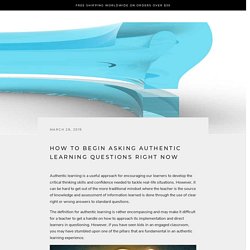
However, it can be hard to get out of the more traditional mindset where the teacher is the source of knowledge and assessment of information learned is done through the use of clear right or wrong answers to standard questions. The definition for authentic learning is rather encompassing and may make it difficult for a teacher to get a handle on how to approach its implementation and direct learners in questioning. However, if you have seen kids in an engaged classroom, you may have stumbled upon one of the pillars that are fundamental in an authentic learning experience.
Authentic Assessment. Authentic Assessment & Engagement. Steps to Creating the Conditions for Deep, Rigorous, Applied Learning. The Clash of the Titans – Two Types of Authentic Tasks. It has dawned on me recently that two of My Ed Heroes, Gary Stager and Bernie Dodge, have somewhat opposing viewpoints (at least it seems that way to me) of what learners should involve themselves in when they learn in a particular content area.
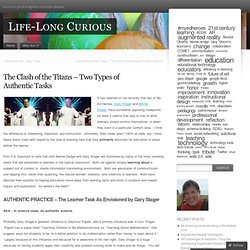
I think the difference is interesting, important, and instructive. Ultimately, their views aren’t 100% at odds, but I think these titans clash with regard to the type of learning task that they primarily advocate for educators to place before the learner. First it is important to note that both Bernie Dodge and Gary Stager are frustrated by many of the mind numbing tasks that are presented to learners in the typical classroom. Both rail against simply learning about a subject out of context in sterile information transferring environment. Both are advocates of constructivism and tapping into, rather than quashing, the natural wonder, intensity, and creativity of learners. Khan Academy: The Illusion of Understanding (Part 1) Guest blog by Dr.

Marc SchwartzProfessor of Education at the University of Texas at ArlingtonDirector of the Southwest Center for Mind, Brain, and Education This post is based on an article by the same name published in the Journal of Asynchronous Learning Networks. The Illusion of Understanding For the past three decades I’ve been working to dispel myself of an illusion that’s hard to recognize and even harder to overcome. I call it the “Illusion of Understanding.” It’s the false belief that we understand something but then we discover we actually don’t. How Do Rubrics Help? Rubrics are multidimensional sets of scoring guidelines that can be used to provide consistency in evaluating student work.
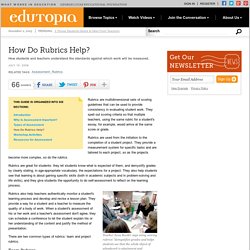
They spell out scoring criteria so that multiple teachers, using the same rubric for a student's essay, for example, would arrive at the same score or grade. Rubrics are used from the initiation to the completion of a student project. They provide a measurement system for specific tasks and are tailored to each project, so as the projects become more complex, so do the rubrics. Rubrics are great for students: they let students know what is expected of them, and demystify grades by clearly stating, in age-appropriate vocabulary, the expectations for a project. Comprehensive Assessment: A New York City Success Story. Write a Great Authentic Task. Project-based Learning engages students in projects that allow them to construct their own knowledge and develop authentic products while dealing with real-world issues.
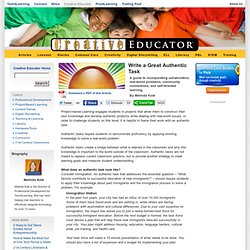
In order to challenge students on this level, it is helpful to frame their work with an authentic task. Write a Great Authentic Task. Ten Takeaway Tips for Using Authentic Assessment in Your School. The School of the Future's (SOF) mission is to empower each and every student.

Teachers accomplish this not only by making their classroom content and instruction engaging but also by making their assessments authentic. Teachers ask SOF students to demonstrate their comprehension and mastery of the curriculum in ways that are meaningful to them. This goes beyond getting the "right" answers on tests. Mobile tech offers potential for formative assessment, authentic learning. Mobile learning has potential for continuous assessment, ‘out-of-the-box’ instruction Policy makers and educators should not ignore the fact that mobile technology holds great potential for student engagement, continuous formative assessment, and authentic learning experiences, according to speakers during a Brookings Institution panel on mobile learning.
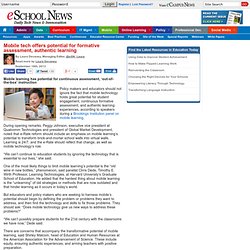
During opening remarks, Peggy Johnson, executive vice president at Qualcomm Technologies and president of Global Market Development, noted that e-Rate reform should include an emphasis on mobile learning’s potential to transform brick-and-mortar school walls into virtual walls. Learning is 24/7, and the e-Rate should reflect that change, as well as mobile technology’s role.
“We can’t continue to education students by ignoring the technology that is essential to our lives,” she said. One of the most likely things to limit mobile learning’s potential is the “old wine in new bottles,” phenomenon, said panelist Chris Dede, Timothy E. Innovative Teaching Showcase 2001-02: Authentic Learning. By Ann Carlson Curriculum and Program Developer Office of the Vice Provost of Undergraduate Education By definition, the term "authentic learning" means learning that uses real-world problems and projects and that allow students to explore and discuss these problems in ways that are relevant to them.
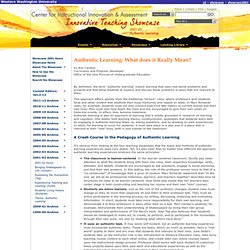
This approach differs greatly from the traditional "lecture" class, where professors give students facts and other content that students then must memorize and repeat on tests. In Marc Richards' class, for example, students must not only connect post-Civil War history to current events and their own lives, they must also help teach the class and are encouraged to give their own views on historical events. In effect, they become historians. Authentic Student Learning. Authentic Learning. What is authentic learning?

Let me ask you a question...If you were going to teach a child about the weather, how would you do it? (Franklin's Forecast?) When I think of my own childhood, I remember being taught about the weather through posters on the wall that had drawings of the seasons. I learned that snow falls in the Winter, the leaves change color in the Fall, flowers bloom in the Spring and i t is always sunny in the Summer. I learned all of this despite the fact that where I grew up (in sunny Southern California) it had never snowed, the leaves never re ally went through a drastic color change, and there always seemed to be flowers blooming.
What Do We Mean by Authentic Learning? CC licensed photo shared by Flickr user horizontal.integration It’s action research time for my Professional Learning Practice cohort, and through our project design we hope to engage our students in relevant, connected, and authentic learning experiences.
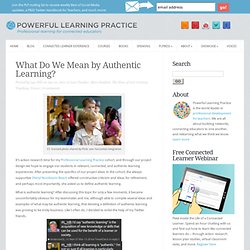
After presenting the specifics of our project ideas to the cohort, the always-supportive Sheryl Nussbaum-Beach offered constructive criticism and ideas for refinement, and perhaps most importantly, she asked us to define authentic learning. Meridian Article: Authentic Learning: A Practical Introduction & Guide for Implementation.
Eli3009. 7.PerformanceAssessment. Performance Assessment. Performance Assessment By Samuel J. Meisels, Ed.D. Most standardized tests are not designed to evaluate the individualized growth and development taking place in your classroom. But there are assessment tools that do! Many early childhood educators are uncomfortable with the idea of testing the young children they work with. This is because the assessment tools they know were designed primarily for older elementary-school students. In recent years, however, a new approach to assessment has been gaining acceptance among early childhood and primary grade teachers.
El_199205_meyer. Using authentic tasks for classroom instruction. As a new teacher, I often find that many things happen unexpectedly, which can make following lesson plans or teaching models to a T difficult. Ensuring that format is followed while working with unexpected variables can sometimes prevent educators from connecting with students. Only on days where a structured lesson balances with the voices and climate of the class community do I feel like I had a successful class. Educational philosophers note that one of the missing links in curriculum design is the fact that students might have difficulty accessing the skills or content because it is not linked to their prior knowledge or their lives in concrete ways. Authentic Task- Based Materials: Bringing the Real World Into the C... Implementing Authentic Tasks in Web-Based Learning Environments (EDUCAUSE Quarterly.
Implementing Authentic Tasks in Web-Based Learning Environments The instructor's inclusion of authentic activities improves the quality of student interaction and learning in online classrooms By Younghee Woo, Jan Herrington, Shirley Agostinho, and Thomas C. Reeves Students studying a computer simulation of global warming share ideas about factors influencing global temperatures. They vary the amount of greenhouse gases emitted by vehicles and factories or manipulate the quantity of green plants in the simulation. Enaged Students – Authentic Tasks – Disguised Learning. I had the opportunity this week to work with a middle school French class. The current curriculum was addressing occupations. The students were being introduced to the vocabulary associated with this topic. Students in the class were assigned the task of researching and presenting a final project that documents what they learned about their occupation.
Of course, the entire projected needed to be written and presented in French. I worked with the teacher, Mrs. What we decided to assign is a “Fakebook” profile. What is a Authentic task. Authentic Tasks. The instructional activities teachers provide for their students play an integral role in shaping what is learned in classrooms. These activities, often referred to as tasks, are what students do to learn academic content and skills.
Tasks provide a structure and goal for learning in classrooms and require time to accomplish. They are meant to engage students in an action, or sequence of actions, that require the application and production of knowledge. Some types of tasks are authentic, which means they are situated in meaningful contexts that reflect the way tasks might be found and approached in real life. Authentic tasks can encompass everyday situations, such as organizing to make and sell t-shirts for a community fundraiser, or real-world activities undertaken in disciplines, such as conducting an historical inquiry into the Lewis and Clark expedition. Authentic Tasks. Authentic Tasks. On-site PD. Authentic Performance Tasks require students to use skills, strategies, and knowledge learned while completing a real-world task.
Students must explain, apply, or synthesize their knowledge to show true understanding through a multiple step process or project. Learn how to develop ready-to-use performance tasks, examine the rubrics for assessing student proficiency, and acquire practical tools for effective implementation in the classroom. Authentic learning 2: AUTHENTIC TASKS. AuthenticPerformanceTask-Sum2010 - 4) Sample Authentic Performance Tasks. Now it is your turn to try your hand at writing an Authentic Performance Task. Write a task that will work with the unit you have been focusing on during this course or for a unit that you are currently planning. If you get stuck, the following site set up by Jay McTighe has some websites with examples to spark your creative energy. To make sure that everyone can read each other's task, make sure to give your task a name, indicate which planning template (from CAP) it relates to, and then use the editor tool bar to insert a horizontal rule after your task.
Exemplars: Authentic Learning. Authentic Tasks. Authentic tasks. Designing Authentic Learning Tasks. The traditional approach to instructional design has been bruised and battered for some years now. Designing Authentic Tasks… « Authentic Assessment. Write a Great Authentic Task. Framework - Authentic Task Design. Designing Authentic Learning Tasks. Step 2: Create the Authentic Task.